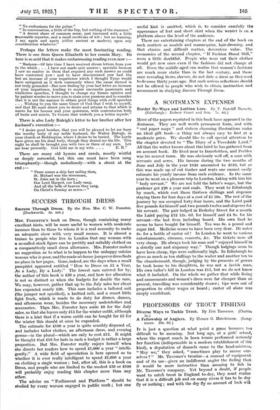SUCCESS THROUGH DRESS
Success Through Dress. By the Hon. Mrs. C. W. Forester. (Duckworth. 5s. net.) MRS. FORESTER'S book on Dress, though containing many excellent hints, will be more useful to women with moderate incomes than to those to whom it is a real necessity to make an adequate show with very small means. It is almost a truism to people who live in London that any woman with a so-called stock figure can be prettily and suitably clothed on a comparatively small dress allowance. Mrs. Forester makes no suggestion as to what is to happen to the unhappy outsize woman who is poor, and the made-at-home jumper or dress finds no place in her pages. Gone, indeed, are the days when a small pamphlet appeared entitled " How to Dress on £5 a Year, As a Lady, By a Lady." The lowest sum catered for by, the author of this book is £50 a year, and here her allocation is not so distinct as when she budgets for double the sum. We may, however, gather that up to the July sales her client has expended nearly £30. This sum includes a tailored suit (the jumper not specified), a knitted suit, and a smart little light frock, which is made to do duty for dinner, dances, and afternoon wear, besides the necessary underclothes and accessories. Then Mrs. Forester lays aside £8 for the July sales, so that she leaves only £15 for the winter outfit, although there is a hint that if a warm outfit can be bought for £5 for the winter this should at once be expended.
The estimate for £100 a year is quite sensibly disposed of, and includes tailor clothes, an afternoon dress, and evening gowns—in the plural—which are only to cost £12. It might be thought that £10 for hats in such a budget is rather a large proportion. But Mrs. Forester really enjoys herself when she directs her, readers how to spend £1,000 a year " intelli- gently." A wide field of speculation is here opened as to whether it is ever really intelligent to spend £1,000 a year on clothing a single woman ; but, after all, this is a book on Dress, and people who are limited to the modest £50 or £100 will probably enjoy reading this chapter more than any other.
The advice on " Parliament and Platform " should be studied by every woman engaged in public work but one
useful hint is omitted, which is, to consider carefully the appearance of feet and short skirt when the wearer is on a platform above the level of the audience.
There are entertaining chapters at the end of the book on such matters as models and mannequins, hair-dressing, and that elusive and difficult matter, decorative value. The economics of the second chapter, " If Fashion Stood Still," seem a little doubtful. People who wear out their clothes would get new ones even if the fashions did not change at all. Even the middle-aged can realize that women's fashions are much more static than in the last century, and those once revealing items, sleeves, do not date a dress as they used to do some thirty years ago. But such serious reflections should not be offered to people who wish to obtain instruction and amusement in studying Success Through Dress.


























































 Previous page
Previous page